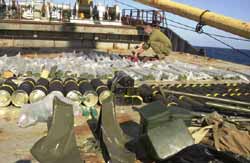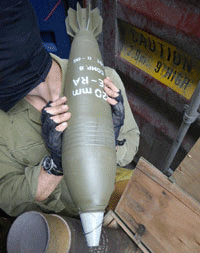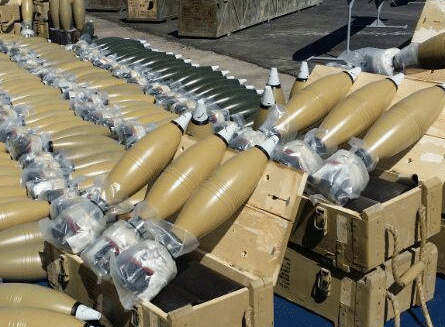Israeli Navy: Intercepting Illegal Weapons Shipments
(Updated February 2015)
Israel's Navy is steadfast in its protection of the Israeli homefront from illegal weapons shipped via the Mediterranean and Red Seas to Hamas terrorists in Gaza or Hezbollah guerrillas in Lebanon. For more than a decade, the Navy has scored numerous successes in intercepting such shipments - keeping thousands of tons of munitions and advanced weaponary out of the hands of those who wish to harm Israel.
- May 2001 (Santorini)
- January 2002 (Karine-A)
- November 2009 (Francop)
- March 2011 (Victoria)
- January 2013
- March 2014 (Klos C)
- February 2015
May 2001 - Santorini
The Navy's first successful interdiction of an illegal arms ship took place in May 2001 when it stopped the "Santorini" on its way from Lebanon to Gaza. The ship was found to be packed with 40 tons of arms sent by a Palestinian faction in Syria.
The Santorini shipment of weapons included Strella anti-aircraft missiles - the kind fired in April 2001 at an Arkia passenger in Kenya - as well as mortars, guns, grenades, mines and explosive material. After the ship was captured, Israel announced the weapons were headed to the Palestinian Authority and its security forces and were destined for use in terror attacks.
In December 2002, an IDF tribunal council held at the Erez checkpoint in Gaza convicted three of the Santorini crew members while the fourth crew member, the son of the ship's captain, was acquitted.
January 2002 - Karine A
In January 2002, Navy commandos from Shayetet-13 - working in tandem with the Air Force - captured a 4,000 ton Palestinian Authority-owned freighter loaded with 50 tons of Iranian and Russian-made weapons. Code-named "Noah’s Ark," the interdiction took place 300 miles south of Eilat in the Red Sea, between the coasts of Saudi Arabia and Sudan.
Ammunition seized on the ship Karine AThe entire operation to overtake the ship took less than ten minutes. The crew - led by Captain Omar Akawi, a lieutenant-colonel in the PA’s Coastal Police and a senior member of PA Chairman Yasser Arafat’s Fatah organization, and 12 others - surrendered without a fight.
Israeli Navy Admiral Yedidya Ya’ari said that the weapons were packed in special floating waterproof containers designed to be dropped into the sea and picked up by smaller craft.
The weapons cache included: 700,000 rounds of small arms ammunition; 735 hand grenades; 311 anti-personnel mines and 211 anti-tank mines; 345 long- and short-range Katyusha rockets with 10 launchers; 29 mortar tubes and 1,545 shells; six Sagger wire-guided anti-tank missle launchers and 10 missiles; 51 RPG-7 anti-tanl missiles and 328 rockets; 30 high-powered Dragonov telescopic rifles; 212 Kalashnikov assault rifles; over 2,000 kilograms of explosives; and, two speedboats with powerful Yamaha engines and a range of diving equipment.
Defense Minister Binyamin Ben-Eliezer said the PA spent more then $100 million on the arms shipment. PA President Yasser Arafat, meanwhile, denied any connection with the shipment and accused Israel of “propaganda” to thwart the cease-fire efforts of U.S. envoy Anthony Zinni and that Israel has “fabricated” the whole affair.
On October 18, 2004, an Israeli military court sentenced Captain Akawi to 25 years in prison. Two officers, Riad Salah Mustafa Abdullah and Ahmed Mahmud Abed al-Khadi Khiris, were sentenced to 17 years each for their role in the smuggling effort. A fourth suspect, Salem Mahmud Husseini el-Sankri, was freed in a prisoner swap after all the charges against him were dropped.
November 2009 - Francop
On November 3, 2009, a special Israeli naval force detained and boarded a merchant ship carrying the flag of Antigua about 100 miles west of the coast of Israel. The Francop cargo ship was carrying a significant amount of weapons disguised as civilian cargo and was directed to the Ashdod port for further searches on board and a detailed inspection of the cargo.
On November 5, 2009, the IDF finished removing the weaponry from the ship and released a report detailing the final weight of the cache as 320 tons. The weaponry aboard included 9,000 mortar shells, thousands of 107-mm. Katyusha rockets that have a range of 15 kilometers, some 600 Russian-made 122-mm. rockets with a 40-km. range and hundreds of thousands of Kalashnikov bullets. T
he weapons found onboard the ship originated from Iran and were intended for Hezbollah. The weapons uncovered constitute a harsh violation of UN Security Council Resolutions 1747 and 1701 that strictly forbid Iran from exporting any form of weaponry.
Defense officials also criticized Egypt for failing to properly inspect the Iranian containers as specifically required of all Islamic Republic of Iran Shipping Lines (IRISL) by UN Security Council Resolution 1803.
March 2011 - Victoria
On March 15, 2011, IDF Naval commandos intercepted the Liberian-flagged cargo vessel Victoria approximately 200 miles off Israel's coast. The ship was carrying around 50 tons of weapons which, according to assessments, was intended for Hamas terrorists operating in the Gaza Strip.
Following the interception, the IDF alerted German authorities, due to the German ownership of the ship, as well as the government of Liberia, whose flag it was flying under, and France, due to the French shipping company.
The weapons cache on the Victoria included: 230 mortar shells (120 mm); 2,270 mortar shells (60 mm); 6 C-704 anti-ship missiles; 2 radar systems manufactured in England; 2 launchers; 2 hydraulic mounting cranes for radar system; and, 66,960 bullets for Kalashnikov rifles (7.62 mm). The Navy also found C-704 anti-ship missiles equipped with radars and a range of 35 kilometers.
The Navy Chief added that guidebooks in Farsi were found on the ship along with other symbols of the Army of the Guardians of the Islamic Revolution, another indication that the Victoria was an Iranian attempt to shift the order of power in the Middle East.
January 2013
In early January 2013, the navy intercepted a ship containing advanced weaponry destined for Lebanon that flew a Qatari flag and was registered to a Qatari company. Security officials said the ship contained advanced weapons, including anti-aircraft missiles.
A spokeswoman for the IDF refused to confirm or deny the report.
March 2014 - Klos C
In early March 2014, Israeli naval commandos interdicted the Klos C, an Iranian vessel sailing under a Panamanian flag that was making its way to port in Sudan while carrying a cargo of advanced rockets destined for Palestinian terror groups in Gaza.
The Navy intercepted the ship in open waters on the maritime border of Sudan and Eritrea, some 1,500 kilometers south of Israel in the Red Sea. After the bringing the ship back to Israel and performing an in-depth inventory, Israel revealed that the cargo contained 40 Iranian-made 302M ground-to-ground missiles, 181 mortar rounds and 400,000 rounds of 7.62 mm ammunition. The 302M missile was used extensively by Hezbollah to fire on Haifa during the 2006 Second Lebanon War.
According to IDF Intelligence, the weapons originated in Syria, where Iran is known to store large arsenals of weaponry. The rockets were then flown to Tehran and subsequently moved to the Iranian port of Bandar Abbas, where they were loaded onto a civilian cargo ship. The ship stopped in Iraq to load more civilian crates before continuing around the Arabian peninsula.
"There is clear evidence from the ship that these are rockets for which Iran is responsible," a senior IDF source said Wednesday. "The rockets were ... intended for terror groups in Gaza."
February 2015
The Israeli Navy intercepted a boat carrying approximately one ton of rocket manufacturing materials in late January 2015, and the story and video of the incident were cleared for publication three weeks later in February. The siezed materials were headed to Hamas operatives in Gaza from the shores of the Sinai, and the ship was stopped before it reached Gazan shores when Israeli security forces deemed it suspicious. Liquid fiberglass was found on board the boat in addition to cannisters of gasoline.
Sources: Israel Ministry of Foreign Affairs; Jerusalem Post; IDF Spokesperson; Israel Ministry of Foreign Affairs; BBC (January 4, 2002); Ha’aretz (January 4, 2002); Jerusalem Post (January 4, 2002 and October 19, 2004); The Jerusalem Report (September 9, 2002); Haaretz (December 12, 2002); ABS-CBN News (April 11, 2009); WND News (January 30, 2013); Ynet News (March 4, 2014)
Photos: IDF Spokesperson; BBC (August 30, 2009); Times of Israel (March 9, 2014); Ynet News (February 12, 2015)





